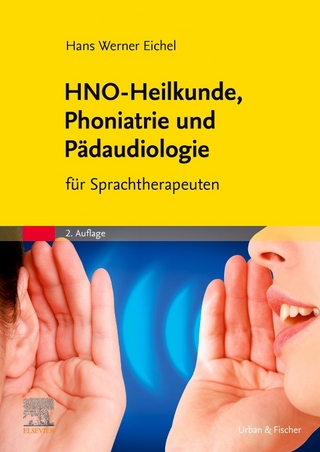
Pediatric Dysphagia
Plural Publishing Inc (Verlag)
978-1-59756-864-7 (ISBN)
Pediatric Dysphagia: A Multidisciplinary Approach is a comprehensive professional reference on the topic of pediatric feeding and swallowing disorders. Given that these disorders derive from abnormalities in the function and/or structure of the airway and digestive systems, multiple clinical specialists may be involved in the evaluation and management of affected children at any given point in time. This text therefore includes significant contributions from a wide range of experts in pediatric dysphagia, including all members of the Interdisciplinary Feeding Team at Cincinnati Children’s Medical Center. These experts present an in-depth description of their roles in the diagnosis and management of dysphagic children, providing the reader with an understanding of why a multidisciplinary model of care is key to the optimization of outcomes.
Pediatric Dysphagia is divided into five parts. In Part I, readers are provided with an overview of the embryologic development of aerodigestive structures that relate to swallowing, an introduction to neural organization related to swallowing function and physiologic aspects of swallowing, a synopsis of oral motor development, a discussion of the various etiologic categories of feeding and swallowing disorders, and an overview of genetic disorders associated with feeding and swallowing issues. Part II covers the clinical and instrumental assessment of patients, including the interdisciplinary feeding team infrastructure and function, the roles of individual members of the feeding team, the specific diagnostic tests commonly used in the assessment of feeding and swallowing issues, the classification of neonatal intensive care units, and the assessment and management of feeding and swallowing issues encountered in the neonatal intensive care unit. Part III focuses on the management of pediatric dysphagia, covering a wide range of treatment strategies and interventions for children with various categories of feeding disorders. Part IV includes an introduction to the concept of evidence-based practice and the application of evidence-based strategies in the management of dysphagia. Part V presents a brief overview of the role of ethics in healthcare and ethical considerations in the treatment of dysphagic children.
In summary, the overall aim of this comprehensive text is to provide all pediatric professionals involved in the care of dysphagic patients with a basic understanding of the complexity of this disorder, the anatomic, neurologic, and physiologic components involved in this disorder, an overview of the diverse population of children who suffer with this disorder, and with a wide range of management approaches based on patient needs and capabilities. The authors also address clinical problem solving and decision making, inspiring readers to develop multidisciplinary models of care at their own institutions.
Jay Paul Willging, MD, is a Professor of Otolaryngology–Head and Neck Surgery at the University of Cincinnati College of Medicine. He completed his fellowship in pediatric otolaryngology at Cincinnati Children’s Hospital Medical Center (CCHMC) and has been a member of the Division of Pediatric Otolaryngology–Head and Neck Surgery at CCHMC since 1992. He is the Director of the Pediatric Otolaryngology Fellowship Training Program and also the Director of Clinical Operations for the Otolaryngology Division. He has served as the Director of the Interdisciplinary Feeding Team since 1999, and is also an active participant in numerous other multidisciplinary programs, including the Aerodigestive and Esophageal Center, the Craniofacial Anomaly Team, the Fiberoptic Endoscopic Evaluation of Swallowing Safety Clinic, and the Velopharyngeal Insufficiency Clinic. Dr. Willging has numerous peer-reviewed clinical and research publications and has been a longstanding contributor to textbooks on a wide range of otolaryngology topics, particularly feeding and swallowing disorders. Claire Kane Miller, PhD, MHA, CCC-SLP, is the Program Director of the Aerodigestive and Esophageal Center’s Interdisciplinary Feeding Team at Cincinnati Children’s Hospital Medical Center, and holds a clinical and research position in the Division of Speech-Language Pathology at Cincinnati Children’s. She is a field service associate affiliate professor in the Department of Otolaryngology–Head and Neck Surgery at the University of Cincinnati College of Medicine and is also an assistant affiliate professor in the Department of Communication Sciences and Disorders at the University of Cincinnati. Her research and clinical interests are predominantly in pediatric dysphagia. Throughout her career, she has focused on instrumental swallowing assessment and the clinical management of infants and children with congenital and acquired airway anomalies. She has authored numerous publications and has presented both nationally and internationally on diverse aspects of pediatric dysphagia. Aliza P. Cohen, MA, is a medical and science writer who has spent more than three decades working in academic medicine. During this time, she has worked collaboratively with faculty and fellows in pediatric surgery, pediatric neurology, pediatric pulmonary and sleep medicine, and pediatric otolaryngology. She has coauthored numerous articles and book chapters on a wide array of topics within these disciplines and has dedicated her efforts to mentoring fellows and faculty in the pursuit of excellence in writing.
Foreword by Robin T. Cotton
Preface
Acknowledgments
Contributors
Part I. Foundations
Section 1. Embryology
Chapter 1. Embryologic Development of Aerodigestive Structures that Relate to Swallowing
Claire Kane Miller, Aliza P. Cohen, and Jay Paul Willging
Section 2. Neural Control of Swallowing
Chapter 2. Neural Organization Related to Swallowing
Claire Kane Miller, Lisa N. Kelchner, and Jay Paul Willging
Chapter 3. Cranial Nerves Associated with Swallowing
Claire Kane Miller, Lisa N. Kelchner, and Jay Paul Willging
Chapter 4. Three Phases of Swallowing
Claire Kane Miller, Lisa N. Kelchner, and Jay Paul Willging
Chapter 5. Respiration, Swallowing, and Protective Reflexes
Claire Kane Miller, Lisa N. Kelchner, and Jay Paul Willging
Section 3. Oral Motor Development
Chapter 6. Oral Motor Development
Claire Kane Miller, Aliza P. Cohen, and Jay Paul Willging
Section 4. Etiologies
Chapter 7. Syndromes, Sequences, and Associations
Claire Kane Miller, Aliza P. Cohen, and Jay Paul Willging
Chapter 8. Neurologic Etiologies
Claire Kane Miller, Aliza P. Cohen, and Jay Paul Willging
Chapter 9. Structural Etiologies
Claire Kane Miller, Aliza P. Cohen, and Jay Paul Willging
Chapter 10. Respiratory Conditions
Claire Kane Miller, Aliza P. Cohen, and Jay Paul Willging
Chapter 11. Cardiac Conditions
Claire Kane Miller, Aliza P. Cohen, and Jay Paul Willging
Chapter 12. Functional Disorders of the Esophagus
Claire Kane Miller, Aliza P. Cohen, and Jay Paul Willging
Chapter 13. Functional Disorders of the Gastrointestinal Tract
Claire Kane Miller, Aliza P. Cohen, and Jay Paul Willging
Chapter 14. Sensory Processing Disorders
Claire Kane Miller, Aliza P. Cohen, and Jay Paul Willging
Chapter 15. Metabolic Disorders
Claire Kane Miller, Aliza P. Cohen, and Jay Paul Willging
Chapter 16. Psychosocial and Behavioral Disorders
Claire Kane Miller, Aliza P. Cohen, and Jay Paul Willging
Section 5. Genetics
Chapter 17. Genetic Syndromes and Disorders and Their Associated Feeding Issues
Claire Kane Miller, Aliza P. Cohen, and Jay Paul Willging
Part II. Clinical and Instrumental Assessment
Section 6. Interdisciplinary Feeding Team
Chapter 18. Team Infrastructure and Function
Claire Kane Miller, Aliza P. Cohen, and Jay Paul Willging
Chapter 19. Role of the Pediatric Otolaryngologist
Jay Paul Willging
Chapter 20. Role of the Pulmonologist
Dan T. Benscoter
Chapter 21. Role of the Pediatric Gastroenterologist
Vincent Mukkada, Aliza P. Cohen, and Jay Paul Willging
Chapter 22. Role of the Registered Nurse
Candace J. Hochstrasser
Chapter 23. Role of the Nurse Practitioner
Candace J. Hochstrasser
Chapter 24. Role of the Registered Dietician
Amy E. Reed
Chapter 25. Role of the Pediatric Speech-Language Pathologist
Claire Kane Miller
Chapter 26. Role of the Occupational Therapist
Elizabeth J. Kirby
Chapter 27. Role of the Social Worker
Sarah M. Weller
Chapter 28. Case Study Reflecting Interdisciplinary Feeding Team Approach
Claire Kane Miller
Section 7. Oral Motor Feeding Assessment
Chapter 29. Clinical Oral Motor Feeding Assessment
Claire Kane Miller, Aliza P. Cohen, and Jay Paul Willging
Section 8. Instrumental Assessment
Chapter 30. The Videofluoroscopic Swallowing Study
Claire Kane Miller, Steven J. Kraus, Aliza P. Cohen, and Jay Paul Willging
Chapter 31. Fiberoptic Evaluation of Swallowing
Claire Kane Miller, Aliza P. Cohen, and Jay Paul Willging
Chapter 32. Adjunctive Diagnostic Testing in the Evaluation of Pediatric Dysphagia
Charles M. Myer IV, Claire Kane Miller, Aliza P. Cohen, and Jay Paul Willging
Section 9. Assessment and Management of Feeding and Swallowing Issues in the Neonatal Intensive Care Unit
Chapter 33. Classification of Neonatal Intensive Care Units
Claire Kane Miller, Alison S. Riley, Brenda K. Thompson, and Ann Clonan
Chapter 34. Selective Conditions Frequently Seen in the Neonatal Intensive Care Unit
Claire Kane Miller, Alison S. Riley, Brenda K. Thompson, and Ann Clonan
Chapter 35. The Neonate in the Neonatal Intensive Care Unit Environment
Claire Kane Miller, Alison S. Riley, Brenda K. Thompson, and Ann Clonan
Chapter 36. Feeding Assessment of Neonates in the Neonatal Intensive Care Unit
Claire Kane Miller, Alison S. Riley, Brenda K. Thompson, and Ann Clonan
Chapter 37. Therapeutic Interventions in the Neonatal Intensive Care Unit
Claire Kane Miller, Alison S. Riley, Brenda K. Thompson, and Ann Clonan
Part III. Management of Pediatric Dysphagia
Section 10. Overview of Treatment Strategies
Chapter 38. Overview of Treatment Strategies
Claire Kane Miller, Aliza P. Cohen, and Jay Paul Willging
Chapter 39. Management of Feeding Issues in Infants and Children with Craniofacial Anomalies
Claire Kane Miller, Aliza P. Cohen, and Jay Paul Willging
Chapter 40. Management of Dysphagia in Children with Underlying Neurogenic Conditions
Claire Kane Miller, Aliza P. Cohen, and Jay Paul Willging
Section 11. Sensory Processing Disorders
Chapter 41. Sensory Processing Disorders and Regulatory Issues that Affect Feeding
Claire Kane Miller and Jennifer Maybee
Chapter 42. Interventions for Sensory Processing Disorders
Claire Kane Miller and Jennifer Maybee
Section 12. Behavioral Feeding Disorders and Intervention Strategies
Chapter 43. Behavioral Feeding Disorders
Claire Kane Miller and Lori B. Vincent
Chapter 44. Behavioral Assessment
Claire Kane Miller and Lori B. Vincent
Chapter 45. Behavioral Feeding Interventions
Claire Kane Miller and Lori B. Vincent
Section 13. Management of Gagging, Retching, and Tube Feeding Issues
Chapter 46. Management of Gagging, Retching, and Tube Feeding Issues
Therese O’Flaherty, Aliza P. Cohen, and Jay Paul Willging
Part IV. Evidence-Based Medicine
Section 14. Evidence-Based Practice and Assessing Outcomes in Pediatric Dysphasia
Chapter 47. Levels of Evidence
Claire Kane Miller
Chapter 48. Components of Evidence-Based Practice
Claire Kane Miller
Chapter 49. Establishing Care Recommendations, Clinical Pathways, and Treatment Protocols
Claire Kane Miller
Chapter 50. Integrating Functional Outcomes in the Dysphagia Treatment Plan
Claire Kane Miller
Part V. Ethics in Pediatric Dysphagia
Section 15. Ethics in Pediatric Dysphagia
Chapter 51. Ethics in Pediatric Dysphagia
Candace Ganz and Claire Kane Miller
Index
| Erscheinungsdatum | 10.05.2021 |
|---|---|
| Verlagsort | San Diego |
| Sprache | englisch |
| Maße | 178 x 254 mm |
| Themenwelt | Medizin / Pharmazie ► Gesundheitsfachberufe ► Logopädie |
| Medizin / Pharmazie ► Medizinische Fachgebiete ► HNO-Heilkunde | |
| Medizin / Pharmazie ► Medizinische Fachgebiete ► Pädiatrie | |
| ISBN-10 | 1-59756-864-3 / 1597568643 |
| ISBN-13 | 978-1-59756-864-7 / 9781597568647 |
| Zustand | Neuware |
| Haben Sie eine Frage zum Produkt? |
aus dem Bereich


